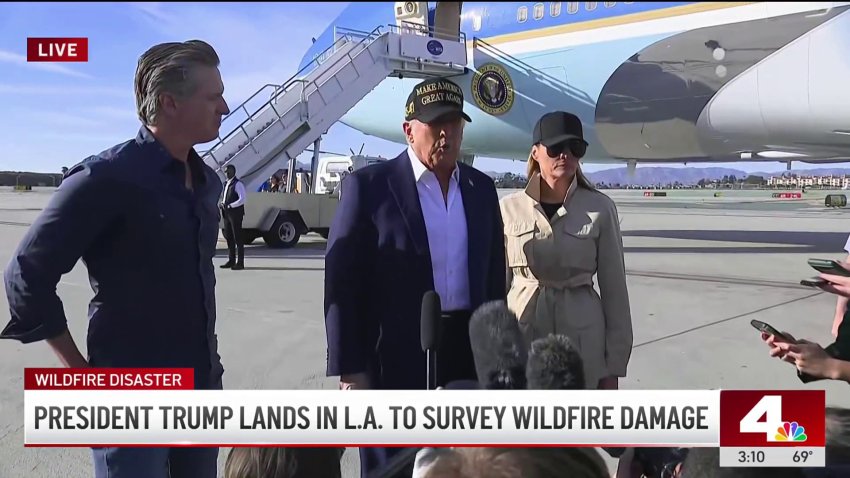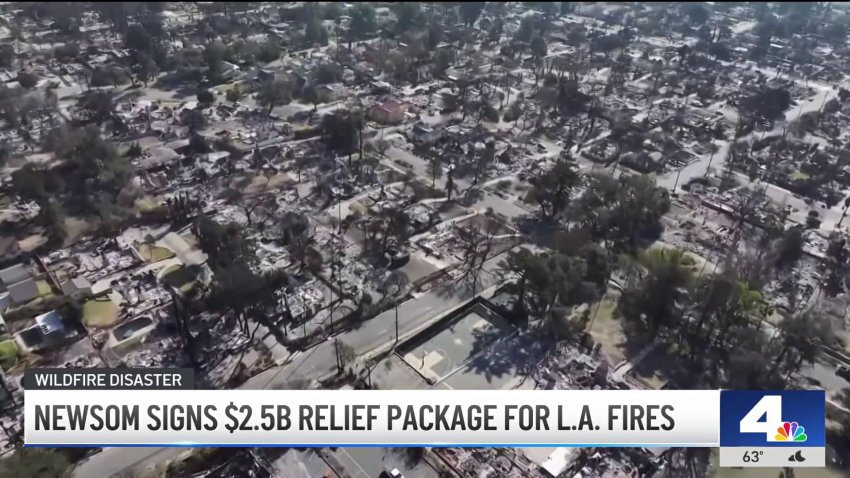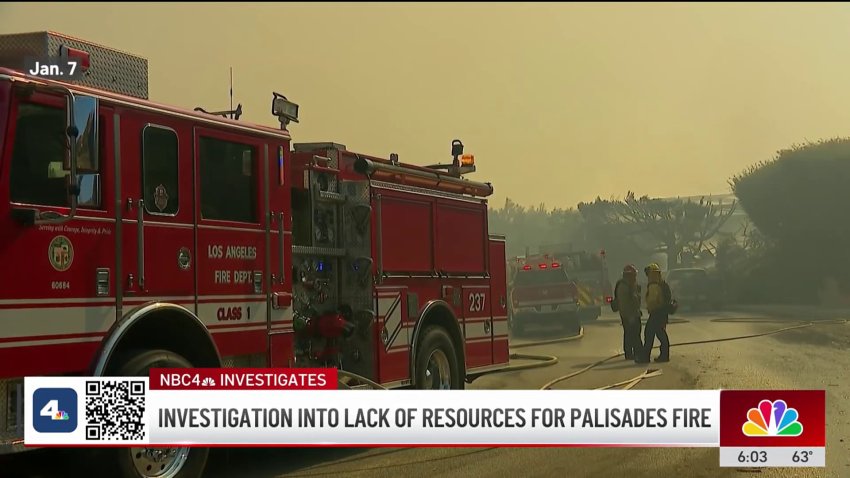What to Know
- President Trump's first trip of his second term in the White House included a stop in Los Angeles to view wildfire damage.
- California lawmakers approved a $2.5 billion fire relief package with bipartisan support that was signed Thursday by Gov. Newsom.
- As of Friday morning, the Palisades Fire on the LA County coast was 77% contained at 23,448 acres. The Eaton Fire in the Altadena area was 95% contained at 14,021 acres.
- The Hughes Fire that sparked in the Castaic area Wednesday morning continues to burn at 10,396 acres with containment on the rise.
- Rain is in the weekend forecast, but rates will be on the lighter side. See the weekend forecast timeline.
President Trump was greeted by Gov. Gavin Newsom when he arrived in Los Angeles Friday for a tour of areas damaged by two of the deadliest and destructive wildfires on record in California.
The visit, the first trip of his second term, included an aerial tour of the damage and a roundtable briefing at a fire station in Pacific Palisades with LA Mayor Karen Bass, LA County Supervisor Kathryn Barger, Congressional delegation members and fire officials.
It was not clear whether Newsom was invited to join Trump, but the two shook hands and spoke in a cooperative tone before cameras at LAX.
We've got the news you need to know to start your day. Sign up for the First & 4Most morning newsletter — delivered to your inbox daily. Sign up here.
"I appreciate the governor coming out and meeting me very much, and we'll be talking,'' Trump, alongside first lady Melania Trump, said. "We want to get it fixed. We want to get the problem fixed.
"It's like you got hit by a bomb."
Newsom thanked the President for visiting and referenced both the Palisades Fire in Pacific Palisades and the Eaton Fire northeast of Los Angeles in Altadena.
"It means a great deal to all of us," Newsom said. "Not just the folks in Palisades, but folks in Altadena that were devastated. We're going to need your support. We're going to need your help. You were there for us during COVID. I don't forget that. And I have all the expectations that we'll be able to work together to get this speedy recovery.''

After touring the destruction, Trump spoke before a fire briefing with local officials.
"You don't realize how rough it is, how bad it is until you see it," Trump said. "It is devastation. It is an incineration."
At the fire briefing, Trump said the federal government will waive or dramatically expedite all federal permits to help expedite the rebuilding process.
"There can be no Golden Age without the Golden State," he said.
The visit comes four days after President Trump's inauguration and a day after state lawmakers approved a more than $2.5 billion fire relief package with bipartisan support in Sacramento.
As for federal fire relief funds, Trump has threatened to withhold federal disaster aid for Los Angeles unless California leaders change the state's approach on its management of water. Trump, whose Los Angeles-area golf course on the Palos Verdes Peninsula is about 45 miles south of fire-ravaged Pacific Palisades, briefly mentioned the fires in his Monday inaugural address.
More than 16,100 structures, including homes and businesses, have been destroyed by the Eaton Fire and Palisades Fire, which started Jan. 7 in an extreme Santa Ana windstorm that fanned flames and tossed hot embers in a nightmare scenario for firefighters. Twenty-eight deaths have been confirmed in the fires.
The cordial meeting at LAX marked a departure from the public back-and-forth involving Trump and Newsom, who have long had a complicated, but functional, relationship. The governor invited Trump to visit as Trump attacked Newsom, former President Joe Biden and Bass on social media in the days after the fires started. The weekend before his second inauguration, Trump said he hasn't spoken directly with Newsom since the wildfires began.
"I invited him out here. I'm glad he's coming out here," Newsom said after signing the relief package Thursday in Altadena. "I hope he does take the time to listen to the folks directly impacted by the wildfires. I hope he has a chance to visit the folks in Altadena, not just in the Palisades. I hope he comes with a spirit of cooperation and collaboration. That's the spirit in which we welcome him."
The two had a sound working relationship during past crises, Newsom said.
"We had a great relationship during Covid. Well established. Well defined," Newsom said. "I don't think there's a Democratic governor in the country that worked more collaboratively with the President of the United States."

The political heavyweights have traded attacks over the fires, which Newsom said he believes will be one of the worst natural disasters in U.S. history. Among the claims promoted by Trump in the hours and days after the fires started was that conservation policies related to a small fish called the Delta smelt affect how much water is pumped from the fish's habitat in the Sacramento-San Joaquin Delta, a central component of the state's water system that supplies fresh water to two-thirds of California's population and millions of acres of farmland.
“I don’t think we should give California anything until they let the water run down,” Trump said in an interview Wednesday with Fox's Sean Hannity, repeating a claim he's made before.
Trump remarked on the trip, including a stop in North Carolina, before departing Friday morning on Marine One on the South Lawn of the White House.
"We're going to then go to Los Angeles and take a look at a fire that could have been put out if they let the water flow, but they didn’t let the water flow," Trump said. "And they still haven't for whatever reason.

"So, I think we're going to have a very interesting time."
Izzy Gardon, Newsom’s director of communications, has called the fish conservation claims "pure fiction." Newsom responded in an earlier interview with NBC News, saying Trump is “somehow connecting the Delta smelt to this fire, which is inexcusable because it’s inaccurate. Also, incomprehensible to anyone that understands water policy in the state."
California's water supply relies on a complex system of channels, aqueducts, dams and reservoirs to deliver water to homes, farms and businesses in the nation's most populous state. Much of it was constructed 50 or more years ago.
The group Restore the Delta, which advocates for the environmental protections in the Sacramento-San Joaquin Delta, issued a statement saying Trump's water diversion assertion "grossly misrepresents the reality of California's water system and the needs of its residents."
"President Trump's claims that Delta water protections cause water shortages and exacerbate wildfires are false," according to the group. "Experts agree that Southern California's water challenges stem from climate-driven drought and infrastructure constraints -- not protections for fish or the Delta.
"This misinformation ignores that Los Angeles reservoirs are currently full and Delta water sustains essential ecosystems and local economies."
In addition to fire weather conditions described by firefighters as among the worst they've ever seen, the early stages of the battle against the Palisades Fire in Pacific Palisades were hampered by water supply issues. Water tanks and some fire hydrants temporarily lost water because of high demand on the first day of the fires, local officials said.
Water pressure issues, at one point and for several hours, impacted the ability to supply water to fire hydrants, officials acknowledged at news conference the morning after the fire started. The hydrants are designed for fighting fires at one or two houses at a time, not hundreds as was the case in the first chaotic hours of the fire, according to authorities.
As for water drops, powerful wind gusts not only fanned flames, but forced the temporary grounding of all firefighting aircraft.

Erik Scott, the LAFD's public information officer, said on X that morning that the LA Department of Water and Power had proactively filled all available storage tanks in the Palisades area. Water availability "was impacted at higher elevations, he said, which affected some fire hydrants due to limited replenishment of water tanks in those areas."
"The extreme demand caused a slower refill rate for these tanks which created a challenge for our firefighting effort," Scott added.
Janisse Quiñones, head of the Los Angeles Department of Water and Power, said at a Jan. 8 news conference that 3 million gallons of water were available when the Palisades fire started but demand was four times greater than ever seen. Refilling the tanks also requires asking fire departments to pause firefighting.
Critics also questioned why the 117-million gallon Santa Ynez Reservoir that contributes water for drinking and firefighting in Pacific Palisades was empty when the fires broke out. The reservoir in the Pacific Palisades has been closed for repairs after a covering designed to preserve water quality tore, according to the Los Angeles Department of Water and Power, which owns and operates it.
Newsom has called for an independent investigation into the hydrants and the reservoir.
There also are lingering questions about whether the City of Los Angeles and its fire department did enough to prepare in the days ahead of the deadly Palisades Fire. Fire officials NBCLA has talked with say it's not clear to them anything would have made a difference in saving homes, given the intensity of the winds and fires.

It's also not clear what sparked the fires, which are the second- and third-most destructive on record in California.
Several smaller fires erupted around Southern California, where the first 23 days of the month included 15 days of red flag warnings, including a stretch of 11 consecutive days. The most recent major fires, the Hughes Fire in Castaic north of Los Angeles, added to what has been a grueling month for firefighters
The region is under severe to extreme drought conditions after a dry start to the wet season in Southern California. After two seasons of above-average rainfall, a months-long dry spell left hillsides covered in dry brush, providing fuel for wildfires.
Under a red flag warning, any fires that do start are more likely to spread at a rapid rate behind strong winds. Flying embers also speed a brush fire's spread. Powerful gusts can cast hot embers for miles, starting spot fires ahead of the main fire line in a nightmare scenario for firefighters.
Preliminary Cal Fire stats illustrate the challenge firefighters in California have been facing in January. So far this year, the state firefighting agency has reported 255 wildfires that burned about 50,600 acres. At this time last year, 87 fires that burned four acres were reported.
The five-year average is 139 fires and 457 acres burned.

